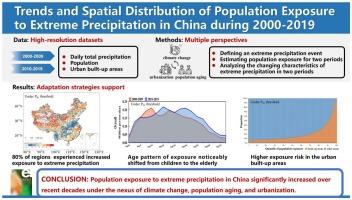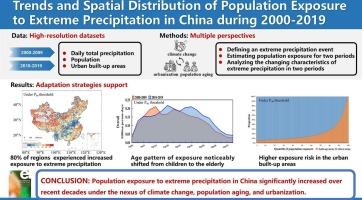2000-2019年中国极端降水人口暴露趋势及空间分布
IF 9.7
1区 环境科学与生态学
Q1 ENVIRONMENTAL SCIENCES
引用次数: 0
摘要
随着全球变暖,极端降水事件变得越来越频繁和强烈,这增加了对公众健康的威胁。在气候变化、人口老龄化和城市化的双重影响下,研究极端降水对人口的暴露,对于了解极端降水暴露的决定因素并采取适应措施至关重要。研究了2000-2019年中国极端降水人口暴露的变化趋势和空间分布特征。我们发现,与2000-2009年相比,2010-2019年中国约80%的地区遭受极端降水的风险增加。在不同强度的极端降水事件中,最大概率密度(MPD)极端降水日数和人口暴露量均有所增加。我们发现,暴露的年龄模式明显从2000-2009年的儿童转变为2010-2019年的老年人。高水平暴露集中在城市建成区,而非城市建成区。这些发现有助于识别高风险地区和人群,在规划应对气候变化下极端降水事件增加的适应行动时应优先考虑这些地区和人群。本文章由计算机程序翻译,如有差异,请以英文原文为准。


Trends and spatial distribution of population exposure to extreme precipitation in China during 2000–2019
Extreme precipitation events are becoming more frequent and intense as the globe warms, which increases threats to public health. Exploring the population exposure to extreme precipitation, especially under the dual impacts of climate change, population aging and urbanization, is essential for understanding the determinants of such exposure and taking adaptive actions. In this study, we explored the trends and spatial distribution of population exposure to extreme precipitation in China during 2000–2019. We found that about 80% of regions in China experienced increased exposure to extreme precipitation during 2010–2019, compared to the period of 2000–2009. The maximum probability density (MPD) extreme precipitation days and population exposure both increased in all three types of extreme precipitation events with different strengths. We found the age pattern of exposure noticeably shifted from children in 2000–2009 to the elderly in 2010–2019. Extremely high-level exposure concentrated in the urban built-up areas rather than the non-urban built-up areas. These findings support to identify the high-risk regions and populations, which should be considered as priorities when planning the adaptation actions to cope with increasing extreme precipitation events under climate change.
求助全文
通过发布文献求助,成功后即可免费获取论文全文。
去求助
来源期刊

Environment International
环境科学-环境科学
CiteScore
21.90
自引率
3.40%
发文量
734
审稿时长
2.8 months
期刊介绍:
Environmental Health publishes manuscripts focusing on critical aspects of environmental and occupational medicine, including studies in toxicology and epidemiology, to illuminate the human health implications of exposure to environmental hazards. The journal adopts an open-access model and practices open peer review.
It caters to scientists and practitioners across all environmental science domains, directly or indirectly impacting human health and well-being. With a commitment to enhancing the prevention of environmentally-related health risks, Environmental Health serves as a public health journal for the community and scientists engaged in matters of public health significance concerning the environment.
 求助内容:
求助内容: 应助结果提醒方式:
应助结果提醒方式:


